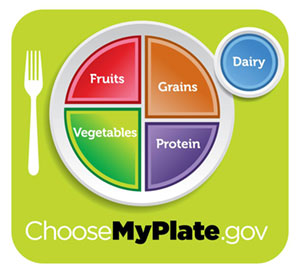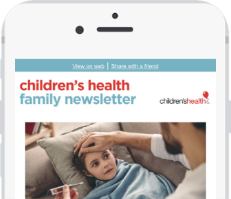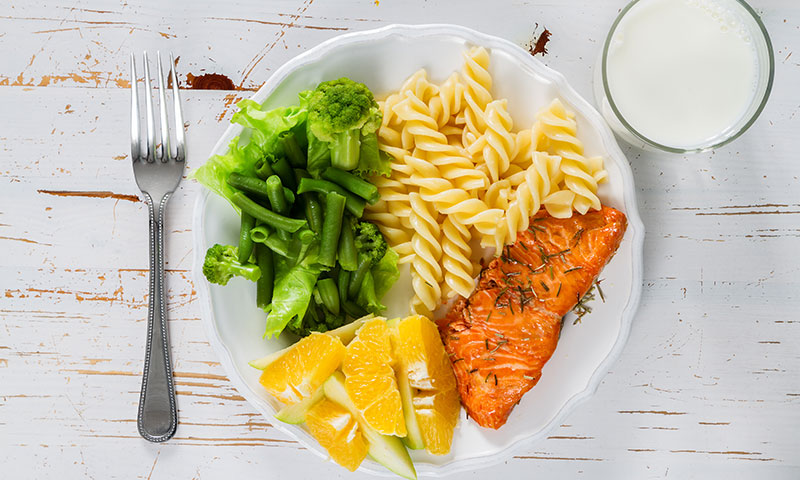Eating a healthy, well-balanced diet is important for everyone – especially for a growing child. But what does a healthy, well-balanced meal consist of and how can parents help their children choose nutritious foods?
MyPlate was introduced by the United States Department of Agriculture in 2011 to replace the food pyramid. It was developed as a tool to model the different components that make up a balanced meal. MyPlate promotes a mix of vegetables, protein, grains and dairy through an easy-to-read plate graphic.
"MyPlate makes it simple to build nutrient-dense meals," says Ashley Kim, Registered Dietitian at Get Up & Go by Children’s Health℠. “It provides a great visual for parents to create a balanced meal with their children.”

How to use MyPlate to build a balanced meal
One of the most important things a parent should keep in mind is that good nutrition and eating healthy is a process. Making healthy food choices doesn't happen overnight. Using the MyPlate tool as a guide can help establish healthy eating habits in the long-term.
According to the MyPlate food model:
- Half the plate should consist of fruits and vegetables
- A quarter of the plate should contain a lean protein such as meat, seafood or plant-based protein
- A quarter of the plate should contain a 100% whole-grain item such as brown rice, pasta or tortillas
- Include low-fat dairy at every meal, either as a drink or as part of the dish
Of course, not all plates will look the same because foods can be combined. For instance, to build a healthy sandwich begin with two slices of whole-wheat bread. Next, add a slice of lean protein, like turkey or chicken breast. Load up on vegetables like lettuce, tomatoes or cucumbers and add a slice of low-fat cheese or a side of low-fat milk for dairy. Lastly, include a side of fruit and you have a balanced meal.
“Variety is key! It is important to eat a balanced diet including all different food groups to ensure the body gets the nutrients it needs,” says Kim. Make it a goal to include at least 3 food groups at each meal and 2 different food groups for each snack.
Dietary restrictions and MyPlate
If your child has food restrictions due to food allergies, lactose intolerance or celiac disease, you can still use MyPlate and substitute the foods your child needs.
For instance, instead of dairy milk, give your child a glass of soymilk for his or her "dairy" serving. For the whole grain serving, if your child must avoid wheat, offer brown rice.
Kim also suggests children with dietary restrictions should see a dietitian to ensure proper nutrition is offered at every meal.
Other tips for a healthy, balanced diet for kids
While MyPlate makes planning for a balanced meal easier, you could still face nutritional challenges with your child, especially if they are a picky eater. Kim offers parents the following advice:
- Make mealtime family time.
Eating regular meals as a family can teach your child valuable social skills as well as provide parents an opportunity to instill healthy eating habits from an early age. Keep family meals positive and avoid pressuring a child to eat certain foods, which can reduce a child’s acceptance of new foods.
- Try preparing veggies in different ways.
Vegetables that are steamed, roasted or raw can taste very different. You can also offer your child cheese or dips, such as light salad dressing or hummus with their vegetables.
- Involve children in meal planning.
Children are more likely to try new foods if they know how to cook. Begin by allowing your child to pick out new vegetables at the grocery store and let them help you with small tasks in the kitchen as they get older. See age-appropriate tips.
- Allow children to express their hunger and fullness.
Avoid requiring your child to clean their plate. Doing so can cause them to ignore their body's signals about hunger and fullness, which can lead to overeating. Encourage your child to develop their hunger and fullness cues by removing all distraction at mealtime. When your child learns and responds to feelings of fullness at a young age, he or she is less likely to overeat.
- Choose healthy snacks.
Even with balanced meals, many growing kids still need snacks. While a meal typically fits on a plate and contains three or more food groups, a snack is a smaller portion with one or two food groups that would fit in one or both hands. Make sure kids are snacking only when hungry, and keep your cupboards stocked with healthy options like fruits, vegetables, fat-free popcorn, string cheese or low-fat yogurt.
- Don’t forget drinks.
Water and low-fat milk are the best drinks for children. Avoid sodas and other sweetened drinks which can add empty calories and get in the way of a healthy diet.
With the right balance of healthy snacks and healthy meals using MyPlate guidance, you can help children receive the energy they need to grow, play and learn.
Register for a free 6-week healthy eating email series
Looking for some encouragement to live a healthier lifestyle? Sign up to receive a weekly weight management tip from clinical dietitians and physicians – straight to your inbox! Register today.
Learn more
Setting goals and making one healthy choice at a time can help your family on the journey to wellness. Learn more about our pediatric weight management programs and services.

Thank you!
You are now subscribed to the Children's Health Family Newsletter.
Children's Health will not sell, share or rent your information to third parties. Please read our privacy policy.
